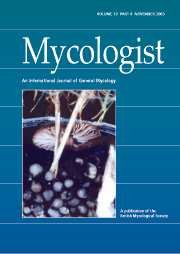Crossref Citations
This article has been cited by the following publications. This list is generated based on data provided by
Crossref.
Tedersoo, Leho
Suvi, Triin
Beaver, Katy
and
Saar, Irja
2007.
Ectomycorrhizas of Coltricia and Coltriciella (Hymenochaetales, Basidiomycota) on Caesalpiniaceae, Dipterocarpaceae and Myrtaceae in Seychelles.
Mycological Progress,
Vol. 6,
Issue. 2,
p.
101.
Kraigher, Hojka
Al Sayegh Petkovšek, Samar
Grebenc, Tine
and
Simončič, Primož
2007.
Types of Ectomycorrhiza as Pollution Stress Indicators: Case Studies in Slovenia.
Environmental Monitoring and Assessment,
Vol. 128,
Issue. 1-3,
2008.
Mycorrhizal Symbiosis.
p.
637.
Finlay, Roger D.
Lindahl, Björn D.
and
Taylor, Andy F.S.
2008.
Stress in Yeast and Filamentous Fungi.
Vol. 27,
Issue. ,
p.
201.
Kraigher, Hojka
Grebenc, Tine
and
Hanke, David E.
2008.
Mycorrhiza.
p.
337.
McLaughlin, David J.
Celio, Gail J.
Padamsee, Mahajabeen
and
Dentinger, Bryn T.M.
2008.
Cystidial structure in two genera of the Russulales.
Botany,
Vol. 86,
Issue. 6,
p.
545.
Scattolin, Linda
Bolzon, Paola
and
Montecchio, Lucio
2008.
A geostatistical model to describe root vitality and ectomycorrhization in Norway spruce.
Plant Biosystems - An International Journal Dealing with all Aspects of Plant Biology,
Vol. 142,
Issue. 2,
p.
391.
Hobbie, E. A.
and
Hobbie, J. E.
2008.
Natural Abundance of 15N in Nitrogen-Limited Forests and Tundra Can Estimate Nitrogen Cycling Through Mycorrhizal Fungi: A Review.
Ecosystems,
Vol. 11,
Issue. 5,
p.
815.
Fazenda, Mariana L.
Seviour, Robert
McNeil, Brian
and
Harvey, Linda M.
2008.
Advances in Applied Microbiology Volume 63.
Vol. 63,
Issue. ,
p.
33.
Remén, Cecilia
Persson, Tryggve
Finlay, Roger
and
Ahlström, Kerstin
2008.
Responses of oribatid mites to tree girdling and nutrient addition in boreal coniferous forests.
Soil Biology and Biochemistry,
Vol. 40,
Issue. 11,
p.
2881.
Hobbie, Erik A.
and
Ouimette, Andrew P.
2009.
Controls of nitrogen isotope patterns in soil profiles.
Biogeochemistry,
Vol. 95,
Issue. 2-3,
p.
355.
Hedh, Jenny
Johansson, Tomas
and
Tunlid, Anders
2009.
Variation in host specificity and gene content in strains from genetically isolated lineages of the ectomycorrhizal fungus Paxillus involutus s. lat..
Mycorrhiza,
Vol. 19,
Issue. 8,
p.
549.
Aponte, Cristina
García, Luis V.
Marañón, Teodoro
and
Gardes, Monique
2010.
Indirect host effect on ectomycorrhizal fungi: Leaf fall and litter quality explain changes in fungal communities on the roots of co-occurring Mediterranean oaks.
Soil Biology and Biochemistry,
Vol. 42,
Issue. 5,
p.
788.
Liang, Jun
Sun, Zhiqiang
Qu, Zhiwei
Zhang, Ying
Lu, Quan
and
Zhang, Xingyao
2010.
Long-term effect of an ectomycorrhizal inoculum and other treatments on survival and growth of Populus hopeiensis Hu et Chow.
Forest Ecology and Management,
Vol. 259,
Issue. 12,
p.
2223.
Hobbie, Erik A.
and
Agerer, Reinhard
2010.
Nitrogen isotopes in ectomycorrhizal sporocarps correspond to belowground exploration types.
Plant and Soil,
Vol. 327,
Issue. 1-2,
p.
71.
Meyer, A.
Grote, R.
Polle, A.
and
Butterbach-Bahl, K.
2010.
Simulating mycorrhiza contribution to forest C- and N cycling-the MYCOFON model.
Plant and Soil,
Vol. 327,
Issue. 1-2,
p.
493.
Remén, Cecilia
Fransson, Petra
and
Persson, Tryggve
2010.
Population responses of oribatids and enchytraeids to ectomycorrhizal and saprotrophic fungi in plant–soil microcosms.
Soil Biology and Biochemistry,
Vol. 42,
Issue. 6,
p.
978.
Tóth, Beáta B.
and
Barta, Zoltan
2010.
Ecological studies of ectomycorrhizal fungi: an analysis of survey methods.
Fungal Diversity,
Vol. 45,
Issue. 1,
p.
3.
Martino, Elena
and
Perotto, Silvia
2010.
Mineral Transformations by Mycorrhizal Fungi.
Geomicrobiology Journal,
Vol. 27,
Issue. 6-7,
p.
609.
Kraigher, Hojka
and
Petkovšek, Samar Al Sayegh
2011.
Diversity and Biotechnology of Ectomycorrhizae.
Vol. 25,
Issue. ,
p.
301.




